Angels in art
_-_Song_of_the_Angels_(1881).jpg)
Angels have appeared in works of art since early Christian art, and they have been a popular subject for Byzantine and European paintings and sculpture.
Angels are usually intended, in both Christian and Islamic art, to be beautiful, though several depictions go for more awesome/frightening attributes, notably in the depiction of the living creatures, ophanim and cherubim. As a matter of theology, they are spiritual beings who do not eat or excrete and are genderless. Many angels in art may appear to the modern eye to be gendered as either male or female by their dress or actions, but until the 19th century, even the most female looking will normally lack breasts, and the figures should normally be considered as genderless. In 19th-century art, especially funerary art, this traditional convention is sometimes abandoned.
Christian art

In the Early Church
Specific ideas regarding how to portray angels began to develop in the early Church. Since angels are defined as pure spirits, [1][2] the lack of a defined form has allowed artists wide latitude for creativity.[3] Daniel 8:15 describes Gabriel as appearing in the “likeness of man” and in Daniel 9:21 he is referred to as “the man Gabriel.” Such anthropomorphic descriptions of an angel are consistent with previous descriptions of angels, as in Genesis 19:5.[4] They were usually depicted in the form of young men.[5]
The earliest known Christian image of an angel, in the Cubicolo dell'Annunziazione in the Catacomb of Priscilla, which is dated to the middle of the third century, is a depiction of the Annunciation in which Gabriel is portrayed without wings. Representations of angels on sarcophagi and on objects such as lamps and reliquaries of that period also show them without wings,[6] as for example the angel in the Sacrifice of Isaac scene in the Sarcophagus of Junius Bassus.
In a third-century fresco of the Hebrew children in the furnace, in the cemetery of St. Priscilla, a dove takes the place of the angel, while a fourth-century representation of the same subject, in the coemeterium majus, substitutes the Hand of God for the heavenly messenger.[7]
The earliest known representation of angels with wings is on what is called the Prince's Sarcophagus, discovered at Sarigüzel, near Istanbul, in the 1930s, and attributed to the time of Theodosius I (379-395).[8] Flying winged angels, very often in pairs flanking a central figure or subject, are derivations in visual terms from pairs of winged Victories in classical art.[5]
In this same period, Saint John Chrysostom explained the significance of angels' wings: "They manifest a nature's sublimity. That is why Gabriel is represented with wings. Not that angels have wings, but that you may know that they leave the heights and the most elevated dwelling to approach human nature. Accordingly, the wings attributed to these powers have no other meaning than to indicate the sublimity of their nature."[9]
From then on Christian art generally represented angels with wings, as in the cycle of mosaics in the Basilica di Santa Maria Maggiore (432-440).[10] Multi-winged angels, often with only their face and wings showing, drawn from the higher grades of angels, especially cherubim and seraphim, are derived from Persian art, and are usually shown only in heavenly contexts, as opposed to performing tasks on earth. They often appear in the pendentives of domes or semi-domes of churches.
Byzantine art
Angels appear in Byzantine art in mosaics and icons. Artists found some of their inspiration from winged Greek figures such as "Victory". They also drew from imperial iconography. Court eunuchs could rise to positions of authority in the Empire. They performed ceremonial functions and served as trusted messengers. Amelia R. Brown points out that legislation under Justinian indicates that many of them came from the Caucasus, having light eyes, hair, and skin, as well as the “comely features and fine bodies” desired by slave traders.[11] Those "castrated in childhood developed a distinctive skeletal structure, lacked full masculine musculature, body hair and beards,....” As officials, they would wear a white tunic decorated with gold. Brown suggests that "Byzantine artists drew, consciously or not, on this iconography of the court eunuch".[11]
Daniel 10: 5-6 describes an angel as clothed in linen and girt with gold.[2] Angels, especially the archangel Michael, who were depicted as military-style agents of God, came to be shown wearing Late Antique military uniform. This could be either the normal military dress, with a tunic to about the knees, armour breastplate and pteruges, but also often the specific dress of the bodyguard of the Byzantine Emperor, with a long tunic and the loros, a long gold and jewelled pallium restricted to the Imperial family and their closest guards, and in icons to archangels. The basic military dress it is still worn in pictures into the Baroque period and beyond in the West, and up to the present day in Eastern Orthodox icons. Other angels came to be conventionally depicted in long robes.
Medieval art
Medieval depictions of angels borrow from the Byzantine. In the French Hours of Anne of Brittany, Gabriel wears a dalmatic.[12] In the later Middle Ages they often wear the vestments of a deacon, a cope over a dalmatic, especially Gabriel in Annunciation scenes - for example The Annunciation by Jan van Eyck. This indicated that, for all their powers, they could not perform the Eucharist, and were in this respect outranked by every priest, reinforcing the prestige of the clergy. In Early Christian art white robes were almost invariably adopted, sometimes bound with the "golden girdle" of Revelation. During the mediæval period senior angels were often clad in every brilliant colour,[13] while junior ranks wore white. Early Renaissance painters such as Jan van Eyck and Fra Angelico painted angels with multi-colored wings. Depictions of angels came to combine medieval notions of beauty with feminine ideals of grace and beauty, as in da Panicale's 1435 Baptism of Christ.[1]
Renaissance art
.jpg)
The classical erotes or putto re-appeared in art during the Italian Renaissance in both religious and mythological art, and is often known in English as a cherub, the singular of cherubim, actually one of the higher ranks in the Christian angelic hierarchy. They normally appear in groups and are generally given wings in religious art, and are sometimes represented as just a winged head. They generally are just in attendance, except that they may be amusing Christ or John the Baptist as infants in scenes of the Holy Family.
Victorian art
In the late 19th century artists' model Jane Burden Morris came to embody an ideal of beauty for Pre-Raphaelite painters. With the use of her long dark hair and features made somewhat more androgynous, they created a prototype Victorian angel which would appear in paintings and stained glass windows. Roger Homan notes that Edward Burne-Jones and others used her image often and in different ways, creating a new type of angel.[14]
Islamic art
According to Islamic teaching, angels are made of light, are beautiful, and have wings; although the shape and form of the wings are unknown.[15] In Islamic art angels mainly appear mainly in narrative scenes in miniature painting, in the Persian Mughal and Ottoman traditions. They are especially common in illustrations of the Prophet's Mi'raj, one of the occasions where their presence is mentioned in the Quran. Their appearance generally draws more from the iconography of pre-Islamic Persia, and Buddhist art, than from angels in Christian art. Some of the earliest Ilkhanid examples are exceptions to this. They have wings, often multi-coloured,[16] and very often floating scarves drawing from Chinese Buddhist art. They are not very common however; many appear in illustrations to biographical accounts of the life of the Prophet Muhammad, which are themselves rare. There are a few studies of angels by themselves, especially from Safavid Persia.
See also
- Archangel Michael in Christian art
- Michael (archangel)
- Gabriel
- Angels in Islam
- Angelus
- Fleur de lys
- List of names referring to El
- Seraph
Galleries of Angels
Christian art
-
The Archangel Gabriel in a deacon's vestments, and multi-colored wings in Jan van Eyck's Annunciation, 1434–36
-
.jpg)
Master of the St Lucy Legend, Mary, Queen of Heaven, c 1480-1510, accompanied by angels, some making music and others investments
-

Guido Reni's Michael (in Santa Maria della Concezione church, Rome, 1636) tramples Satan. A mosaic of the same painting decorates St. Michael's Altar in St. Peter's Basilica.
-

Madonna Surrounded by Seraphim and Cherubim by Jean Fouquet
-

Jacob Wrestling with the Angel by Gustave Doré from La Grande Bible de Tours (1866)
-

God surrounded by Seraphim (Petites Heures of Jean de France, Duc de Berry)
-
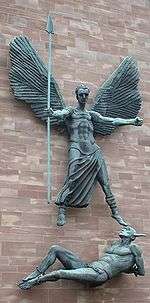
St Michaels Victory over the Devil, a sculpture by Sir Jacob Epstein
-
.jpg)
Lamentation by Giotto di Bondone
-

The Annunciation by Leonardo da Vinci, c. 1472–75
-

Rosa Celeste: by Gustave Doré
-
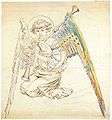
by Jan Matejko
-

Church of Saint Demetrius Patron Saint of Thessaloniki
-

Angel in White by Anonymous, c. 1230, Mileseva Monastery, Republic of Serbia
-
.jpg)
Archangel Gabriel. Part of the mosaic fresco from Gelati Monastery, Georgia c. 12th century
-

Archangel Gabriel Icon by Anonymous, c. 13th century, Saint Catherine's Monastery, Sinai, Egypt
-
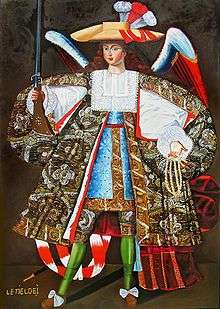
Ángel arcabucero, 17th-century Peru (?)
-
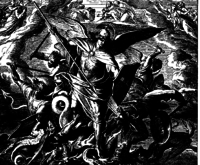
Michael and the Dragon. Die Bibel in Bildern by Julius Schnorr von Carolsfeld, 1860
-

Glasgow. The Barras. Modern sculpture of angel.
Islamic art
-
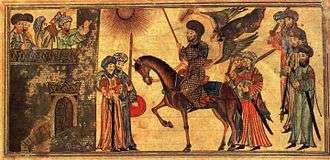
Angel with Mohammad (riding the horse), who receives the submission of the Banu Nadir, from the Ilkhanid Jami Al-Tawarikh, c. 1315
-

A page from 'The Wonders of Creation and the Oddities of Existence' - Egypt/Syria c.1375-1425 AD
-

Persian angel, 1555
Notes
- 1 2 Gorgievski, Sandra. Face to Face with Angels: Images in Medieval Art and in Film, McFarland (2010)ISBN 0786457562, 9780786457564
- 1 2 Longhurst S.T.D., Christopher Evan. "The Science of Angelology in the Modern World: The Revival of Angels in Contemporary Culture", The Catholic Response, Volume IX, No.2, September/October 2012 (pp. 32-36) ISSN 1553-0221
- ↑ "Angels Exist But Have No Wings, Says Church", Skye News, 20 December 2013
- ↑ Everson, David. "Gabriel Blow Your Horn! - A Short History of Gabriel within Jewish Literature", Xavier University, December 2009 Archived 28 April 2014 at the Wayback Machine.
- 1 2 Marshall, Peter and Walsham, Alexandra (editors). Angles in the Early Modern World, p. 5, Cambridege University Press (2006), ISBN 0521843324, 9780521843324
- ↑ Proverbio(2007), pp. 81-89; cf. review in La Civiltà Cattolica, 3795-3796 (2–16 August 2008), pp. 327-328.
- ↑ Hassett, Maurice. "Early Christian Representations of Angels." The Catholic Encyclopedia. Vol. 1. New York: Robert Appleton Company, 1907. 25 Dec. 2013
- ↑ Proverbio(2007) p. 66
- ↑ Proverbio(2007) p. 34
- ↑ Proverbio(2007), pp. 90-95; cf. review in La Civiltà Cattolica, 3795-3796 (2–16 August 2008), pp. 327-328.
- 1 2 Brown, Amelia R., "Painting the Bodiless: Angels and Eunuchs in Byzantine Art and Culture", University of Queensland (2007)
- ↑ Andre, J. Lewis. "The Icons and Emblems of the Holy Angels", The Belfry: Quarterly Papers on Art, History and Archaeology, No. III, Burns & Oates, London, October 1876,
- ↑ Vinycomb, John. Fictitious and Symbolic Creatures in Art, p.30, Chapman and Hall, London(1909)
- ↑ Homan, Roger. "Jane Burden: How a Pre-Raphaelite model changed our image of angels", The Social Affairs Unit, 14 October 2005
- ↑ Islamic Resource & Information Service (IRIS), New Zealand Archived 10 April 2012 at the Wayback Machine.
- ↑ Gamm, Niki. Angels fly on high multicolored wings", Hurriyit Daily News Istanbul, Turkey, 11 August 2012
References
- Proverbio, Cecilia (2007). La figura dell'angelo nella civiltà paleocristiana. Assisi, Italy: Editrice Tau. ISBN 88-87472-69-6.
| Wikimedia Commons has media related to Angels. |

